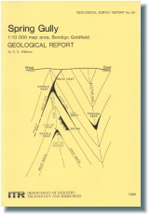GSV Report 85 - Spring Gully 1:10 000 map area, Bendigo Goldfield geological report
 |
| |||||||||||||||
Product description:Download The downloadable version of this report is supplied in PDF format (12.5MB). Abstract This geological report details litho-biostratigraphic and structural mapping of a 40 km2 area surrounding the southern end of the Bendigo goldfield. A deformed Lower Ordovician turbidite sequence affected by lower greenschist facies metamorphism is folded into a set of NNW-SSE trending chevron style folds. About 1200 m of the sequence is exposed at the present erosional surface and is subdivided into biostratigraphic units based on an excellent graptolite fauna. Individual fold hinge zones are very persistent along strike and fold half-wavelengths tend to be uniform along the strike of major folds. Anticline hinge zones are a major control over saddle reef gold-quartz mineralization within the Bendigo goldfield. Strike faults occur throughout the sequence but are difficult to define from surface outcrops. Laminated quartz veins occur as bedding parallel structures which have formed during the early stages of deformation by the 'crack-seal process'. Structural mapping has defined two, and possibly three, structural domains based largely on fold symmetry. The Eastern Structural Domain is characterized by relatively discontinuous and asymmetric folds, a vertical mineral lineation in some slates and a slightly higher metamorphic grade. The major Whitelaw Fault forms the eastern boundary of this domain about 2 km east of the main map area. The Central Structural Domain is characterized by very persistent and symmetric folds and a greater abundance of gold-quartz mineralization. A western area with poor outcrop is probably comprised of discontinuous and asymmetric folds. Jurassic monchiquite dykes occur near anticlinal hinges and a volcanic breccia of possible Jurassic age occurs over a restricted area. Small deposits of Tertiary fluviatile gravels occur in the western part of the map area and the present gully system contains Quaternary alluvium. Bibliographic reference Willman, C.E., 1988. Spring Gully 1:10 000 map area, Bendigo Goldfield geological report. Geological Survey of Victoria Report 85. Related products:
| ||||||||||||||||


